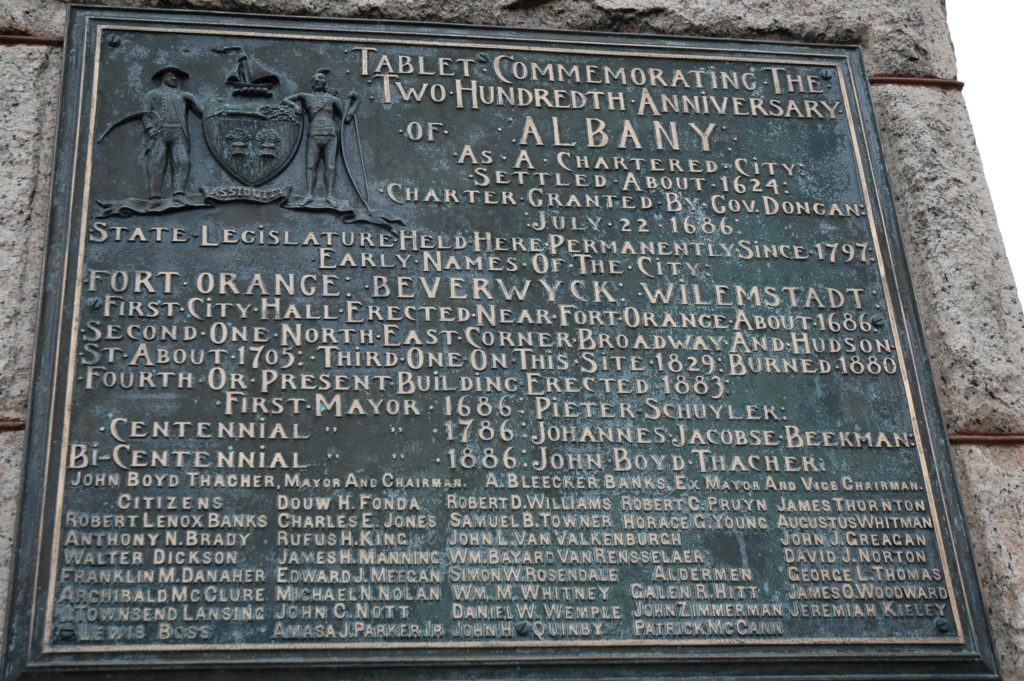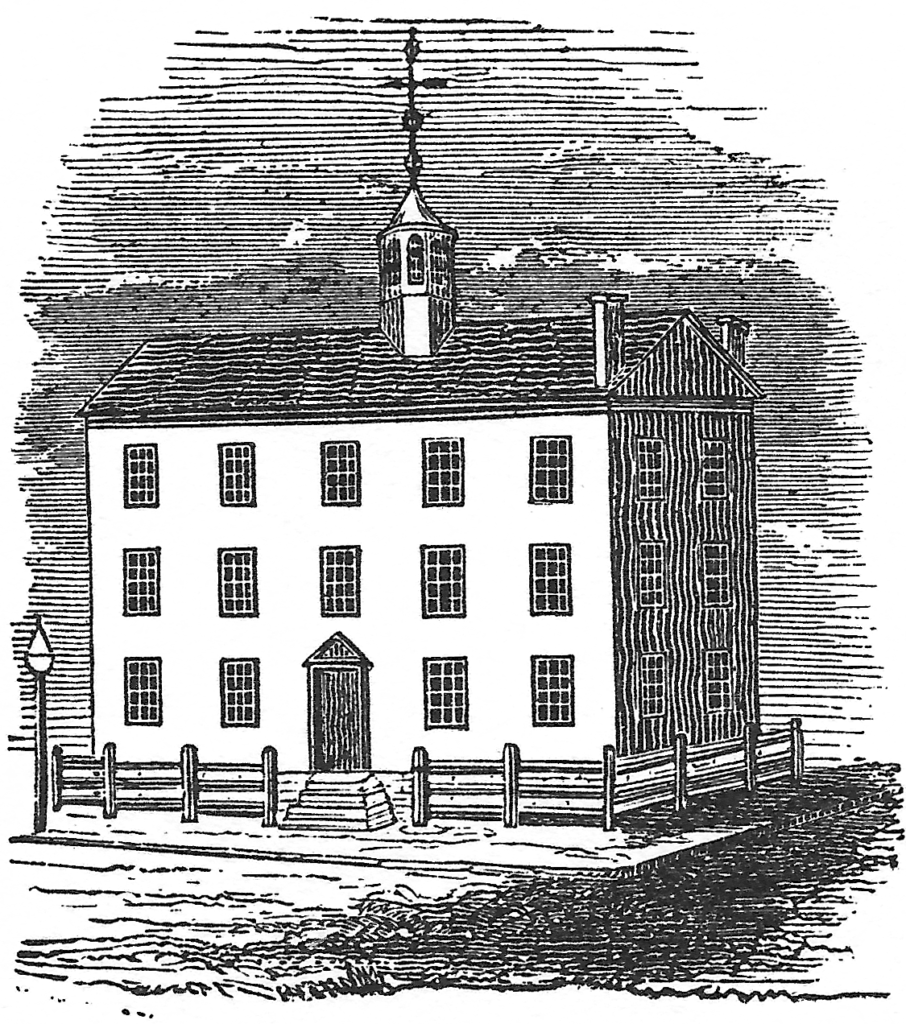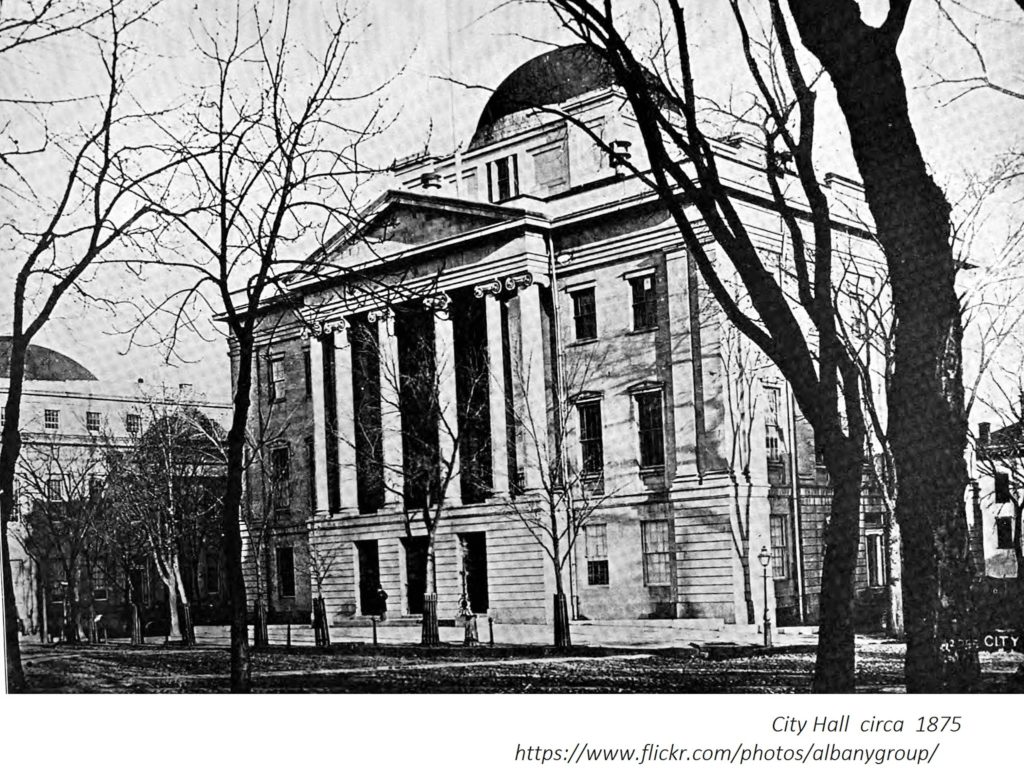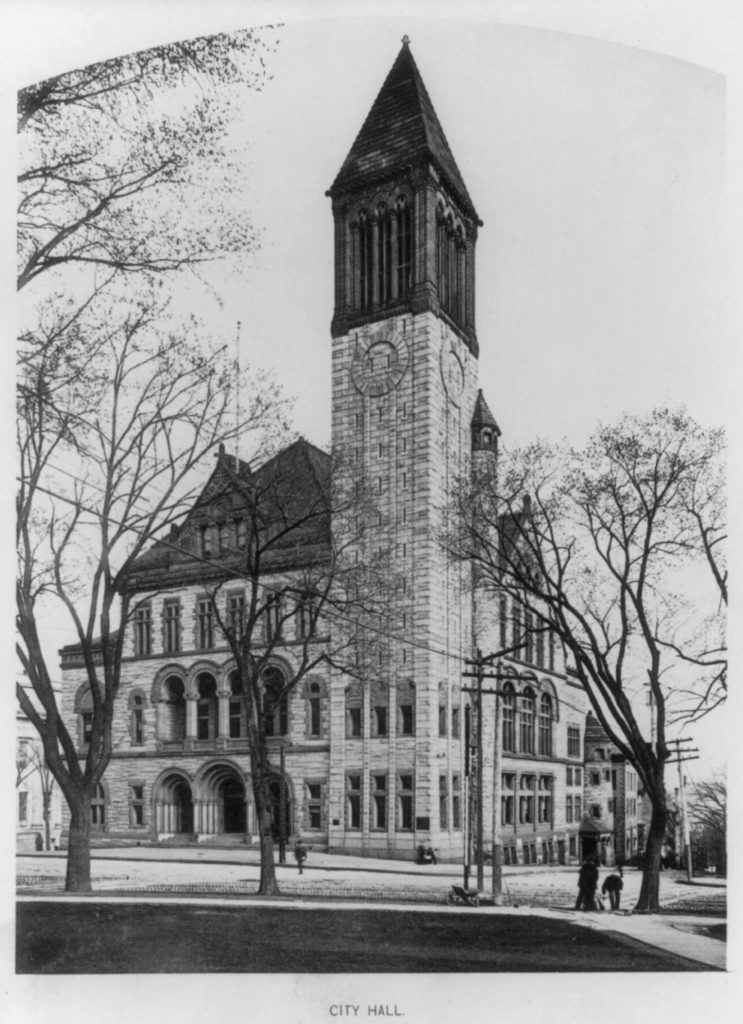Continuing our series on the bronze markers that were placed by the Albany Bicentennial Committee in 1886.
This was the tablet that was described by the Committee on Monumenting and Decoration in its presentation of June 1886. It’s not clear to me whether this was ever cast, or if the copy was changed out for what actually appears on the plaque on the building now. Here’s what was reported as the copy:
Tablet No. 2—Municipal.
A bronze tablet, 32×40 inches, inserted in the exterior surface of the Eagle street wall of the City Hall. It is thus inscribed :
[Correct Coat of Arms of the City.] “Tablet commemorating the 200th anniversary of Albany as a Chartered City. Charter granted by Gov. Dongan, July 22, 1686. Settled about 1624. The time women arrived. Made State Capital 1797. Early names of the City: Fort Orange, Beverwycke, Wilemstadt. First City Hall building erected near Fort Orange about 1686. Second one erected north-east corner of Broadway and Hudson Street about 1705. Third one erected on this site 1829. Burned 1881. Fourth, or Present Building, 1883. First Mayor, 1686, Peter Schuyler; Centennial Mayor, 1786, John Lansing, Jr.; Bi-Centennial Mayor, 1886, John Boyd Thacher. Bi-Centennial Committee.”
It was not thus inscribed. What actually appears on the side of City Hall (around the corner on the Corning Place side, not Eagle Street) is some slightly altered copy. There is no mention of “The time women arrived,” which hadn’t had a specific date attached to it, although that is an important distinction, as it separates Fort Orange the trading post from Rensselaerswyck the settlement. Instead of referring to the State Capital, the tablet mentions the State Legislature being “held here permanently since 1797.” Some spellings were changed, and the names of many rich white men (“citizens”) who ran the Bicentennial Committee and the city were added to the plaque.

This one features some beautiful type, it must be said, and it remains in its very prominent place on the side of the fourth or present City Hall.
The Charter of Albany
The charter of 1686 was granted by Thomas Dongan, governor of New York under the rule of King James II. Its first whereas called the town of Albany “an ancient town;” although it had been occupied only since about 1623, at that point 63 years was ancient. The charter recognized that by then the town had been known by several names (Beverwyck, William-Stadt, and Albany), and that the inhabitants had erected “several public buildings, accommodations and conveniences, for the said town, as also certain pieces or parcels of ground for the use of the same.” Those included the town hall or stadt-house, the church or meeting place, the burial place (“adjoining to the palisades, at the south-east end of the town”), the watch-house, “a certain piece or parcel of land, commonly called or known by the name of pasture, situate, lying and being to the south-ward of the said town, near the place where the old fort stood,” several other pastures and gardens, and a ferry to Greenbush.
The charter established a mayor, aldermen and commonalty of the City of Albany, and continued certain governmental rights and created others. It granted a permanent license to fish in the Hudson River, “not only within the limits of the said city, but without, even so far northward and southward as the river does extend itself, within the said county of Albany.” It also carried a 21-year license to cut down any firewood or timber “as to them shall seem meet and convenient” from any part of the manor of Rensselaerwyck. There was permission to buy from Native Americans 500 acres of low or meadow land at a place “known by the name of Schaaghtecogue,” (today’s town of Schaghticoke in Rensselaer County) as well as 1000 acres of low or meadow land known as Tionnondoroge, on both sides of the river (in the vicinity of Fort Hunter in Montgomery County); the latter required a quit-rent payment to the king of one beaver skin every March 25th.
The charter set the bounds of the city, and created the offices of Mayor, Recorder, Town Clerk, six Aldermen and six Assistants who made up the “Mayor, Aldermen and Commonalty of the city of Albany,” as well as a Chamberlain or Treasurer, a Sheriff, a Coroner, a Clerk of the Market, a High-Constable and three Sub-Constables, and one Marshal or Sergeant at Mace.
The charter expressly named the first men to hold those offices, including Peter Schuyler as the Mayor, and Isaac Swinton as Recorder. The aldermen were Dirk Wessels, Jan Jans Bleecker, David Schuyler, Johannis Wendell, Lavinus Van Schaick, and Adrian Garritse. The Assistants were Joachim Staats, John Lansing, Isaac Verplanck, Lawrence Van Ale, Albert Ryckman, and Melgert Winantse. The Chamberlain was Jan Bleecker, the Sheriff Richard Pretty, and the Marshal James Parker. The annual appointment of the Mayor and Sheriff (made by the Lieutenant Governor), would be on the “feast day of St. Michael, the arch angel, yearly.” In addition to general powers of lawmaking, they were granted express right to license taverns, regulate trade with Indians – and only inhabitants of Albany were allowed to trade or traffic with the Iroquois, or any other nations. It established a city court, a public weigh-house, and set the market days as Wednesday and Saturday, “weekly forever.” The Mayor was the clerk of the market, and most of the government positions served multiple purposes, including on the courts.
City Halls
Albany has had four city halls in its existence. The first was built possibly as early as 1635, and known under the Dutch term of Stadt Huys. Howell’s “Bi-Centennial History of Albany” says it was a three-story structure with a jail on the lowest level, at the northeast corner of modern Broadway and Hudson. A new structure was built at the same site around 1740; while there are no photographs, there are some clear drawings of what it looked like:

Until the first State Capitol was constructed and opened in 1809, the State Legislature met in the City Hall. That first Capitol was essentially in front of the current one, at the top of the hill where State meets Eagle. When it opened, the city government moved there with the state government, and it would be 1832 before a new stand-alone city hall was established, north of the Capitol on the opposite side of Eagle Street, on the same site where City Hall is today. (The land was previously owned by St. Peter’s Church.) The new building was designed by Philip Hooker, who was responsible for most of Albany’s look in the 19th century but whose work has been mostly lost. This particular work was lost to fire on Feb. 10, 1880:

Yes, the plaque put up in 1886 has the wrong date for an event that was only six years earlier. These things happen.
Following the fire, H.H. Richardson, who was contributing to the construction of the new Capitol across the street, received the commission to build a replacement city hall, and he delivered perhaps his most Romanesque design. It’s a stunning, cohesive beauty inside and out, functional and inspiring to this day.

Note that in the image above, the clock was not yet in the clocktower; neither was the carillon, the bells weren’t added until 1927.

Leave a Reply